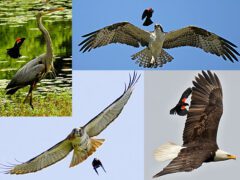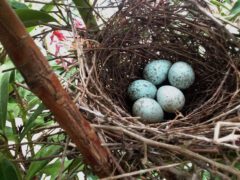Dusky Flycatcher Photo Gallery
A small, round-headed flycatcher with relatively short wings and a long tail. The grayish head contrasts subtly with olive back, though note that plumage color is variable. Vocalizations are extremely important in identifying Empidonax flycatchers.
© Garrett Lau / Macaulay LibraryCalifornia, December 02, 2020The small bill, white eyering, spindly legs, and thin pale wingbars and wing edging help to identify this small flycatcher as an Empidonax. The long tail and short primary projection create a lanky look characteristic of this species. The contrast between the grayish head and olive back is also useful, as is the teardrop-shaped white eyering.
© Kalin Ocaña / Macaulay LibraryBritish Columbia, April 29, 2020Sometimes pumps its tail during aggressive interactions. Note the short primaries and longer-tailed look.
© Timothy Barksdale / Macaulay LibraryMontana, June 01, 2001Not all videos have soundThe long-tailed appearance and “surprised” look imparted by the teardrop-shaped eyering are characteristic. Underparts coloration is often a streaky mix of olive and gray. Bill color is variable.
© Martin Dollenkamp / Macaulay LibraryBritish Columbia, September 06, 2017Small flycatcher with a grayish olive back and a pale grayish belly. The primary feathers are shorter than Hammond's Flycatcher, giving it a long-tailed look.
© Brian Sullivan / Macaulay LibraryCalifornia, April 13, 2021Found in willow thickets, aspen groves, and open evergreen forests.
© Larry Arbanas / Macaulay LibraryTexas, May 02, 2008Not all videos have soundThis bird's rounded head, teardrop-shaped eyering, and combination of short wingtips and relatively long tail suggest Dusky Flycatcher. Vocalizations are extremely important when identifying Empidonax flycatchers, and some individuals cannot be identified by visual characteristics alone.
© Gregory Johnson / Macaulay LibraryWashington, April 27, 2020Compare with Similar Species
Click on an image to compare
Species in This Family
Tyrant Flycatchers(Order: Passeriformes, Family: Tyrannidae)
More to Read
Don't miss a thing! Join our email list
The Cornell Lab will send you updates about birds,
birding, and opportunities to help bird conservation.






































